Injury Risk in Rugby
With Rugby becoming more and more popular, an increasing number of people are enjoying participating in a sport where injury is a very real possibility and an accepted risk.
The intensity of the action means that injuries become part and parcel of the game.
Studies at the University of Bath have shown that for every 1000 hours of international rugby there are 58 injuries. This compares to 17 for international football and just 2.8 for international cricket.
Therefore, more and more rugby teams use Chiropractic to keep their payers off the bench with injuries.
Types of Injuries in Rugby
Many situations around the rugby field particularly increase the chance of injury occurring, such as tackling or scrummaging.
The average force through the shoulder during a tackle is 166kg and stresses are passed right through the body to the neck, upper back, arms, low back, hips, knees and ankles.
Injuries don’t just occur with contact, as with any physical activity overuse injuries can also occur.
As with many sports, rugby injuries fall into two categories: traumatic and overuse.
Traumatic injuries usually result from tackles or collisions with other players and are often unavoidable, even during training.
Concussions, ligament damage and fractures do occur on the pitch although the impact and severity of these traumatic injuries can be reduced by:
- maintaining a good level of fitness,
- good technique at all times as well as
- wearing gum shields, headgear and shoulder pads.
Overuse injuries build over time and are the result of the combined negative effects of a mildly traumatic action that’s repeated over and over again.
Shin splints that result from regular training and practicing is an example of an overuse or chronic injury. The injury usually starts as a niggling discomfort with increasing pain developing over time.
It is also common for an overuse injury to develop into an acute traumatic injury where a succession of micro-traumas weakens the area making it more susceptible to injury. Sudden sprains, muscles and ligament tears often occur in this manner.
Most Common Injuries in Rugby
The most common rugby injuries are leg injuries such as groin or hamstring strains where adductor or hamstring muscles are stretched beyond their limits.
Strain injuries can vary in intensity but are usually painful and result in swelling, bruising and a reduced ability to use the affected muscle.
The same occurs for a sprain of the ligaments that support the joints becoming over-stretched. Pain, swelling and bruising occur along with difficulty moving the joint.
Joints commonly affected in this way during rugby participation are shoulder, low back and sacroiliac joints.
Rapid stopping, starting and changing direction also places stress onto the knees and ankles.
The structure of the knee means a ligament injury is most common, with anterior cruciate ligament (ACL), posterior cruciate ligament (PCL) and medial collateral ligament (MCL) strains, ruptures and tears, the most common.
Both the ACL and PCL can be injured or torn by a sudden stop, start and twisting of the knee joint.
Meniscal (‘cartilage’) injuries also commonly occur as a result of twisting, pivoting, decelerating or a sudden impact and sometimes require surgical repair if severe or non-responsive to more conservative care.
Injury Prevention in Rugby
It is important to remember, as with any sport, that prevention is better than cure!
Warming up and stretching properly before and after any sport is vital to reduce injuries, especially in the frequently affected muscle groups such as the groin and hamstrings.
Often, subtle differences in the way you move can place more stress on the joints of our body. The best way to minimise the chances of an injury taking place is to ensure your body is working optimally.
Your Chiropractor will be able to assess how your joints and muscles are working, and identify any areas that could potentially lead to an injury. We will then help to address the problem and to strengthen the areas; working with you to ensure your body is functioning as required.
Pre-habilitation is the way forward, let us know if you want to have a functional examination to identify any weak links or lack of coordination that makes you vulnerable to injury.
Consult Isis Chiropractic Centres for further advice on injury prevention or if you are already suffering.
